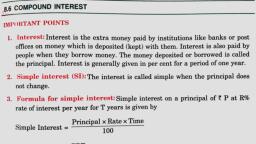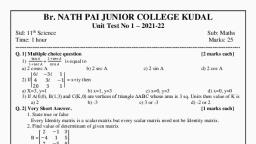Question 3 :
$\cos { \left( \dfrac { \pi }{ 4 } +x \right) } +\cos { \left( \dfrac { \pi }{ 4 } -x \right) } =-\sqrt { 2 } .\cos { x }$<br/>
Question 4 :
If $\displaystyle \tan { \theta } =\frac { 1 }{ 2 } $ and $\displaystyle \tan { \phi } =\frac { 1 }{ 3 } $, then the value of $\displaystyle \theta +\phi $ is:
Question 5 :
$\cos ^{ 4 }{ A } -\sin ^{ 4 }{ A } $ is equal to
Question 6 :
If $\tan\theta +\cot\theta =2$, then the value of $\tan^2\theta +\cot^2\theta$ is __________?
Question 7 :
If $\theta$ is an acute angle such that $\sec^2 \theta = 3$. then the value of $\dfrac{\tan^2 \theta - \text{cosec}^2 \theta}{\tan^2 \theta - \text{cosec}^2 \theta}$ is
Question 9 :
If $\dfrac{x}{y} = \dfrac{{\cos \,A}}{{\cos \,B}}$ then $\dfrac{{x\tan A + y\tan B}}{{x + y}} = $
Question 10 :
$\cos { \left( \dfrac { 3\pi }{ 4 } +x \right) } -\cos { \left( \dfrac { 3\pi }{ 4 } -x \right) } =\sqrt { 2 } .\sin { x }$<br/>
Question 11 :
If $\tan {A}, \tan {B}$ are the roots of $x^{2}-2x +2=0$ then $\tan^{2}({A}+B)=$<br/>
Question 12 :
<div><div>State whether the following statement is true or false.</div></div>If $\cos A+{ \cos }^{ 2 }A=1,$ then ${ \sin }^{ 2 }A+{ \sin }^{ 4 }A=1.$
Question 13 :
If $\tan (\pi \cos \theta) = \cot (\pi \sin \theta)$ then $\cos (\theta - \dfrac{\pi}4)$ is equal to
Question 14 :
The value of $\sin^215^{\small\circ} + \sin^230^{\small\circ} + \sin^245^{\small\circ} + \sin^260^{\small\circ} + \sin^275^{\small\circ}$ is
Question 17 :
If $x = \sin \left (\alpha - \beta \right ) . \sin \left (\gamma - \delta \right ), y = \sin \left (\beta - \gamma \right ) . \sin \left (\alpha - \delta \right )$ and <br/>$\displaystyle z = \sin \left (\gamma - \alpha \right ) . \sin \left (\beta - \delta \right ),$ then
Question 18 :
If in a $\displaystyle\triangle ABC,\sum { \cos { 3A } } =1,$ then exactly one angle of $\triangle$ is
Question 19 :
What is $\sin { { 105 }^{ o } } +\cos { { 105 }^{ o } } $ equal to?
Question 20 :
If $\tan { B } =\cfrac { n\sin { A } \cos { A } }{ 1-n\cos ^{ 2 }{ A } } $ then $\tan { \left( A+B \right) } $ equals<br>
Question 21 :
If $\displaystyle \cos { 2B } =\frac { \cos { \left( A+C \right) } }{ \cos { \left( A-C \right) } } $, then $\tan { A } ,\tan { B } ,\tan { C } $ are in
Question 23 :
In a $\displaystyle \triangle PQR, \angle R=\frac{\pi }{2}.$ If $\displaystyle \tan \frac{P}{2}$ and $\displaystyle\tan \frac{Q}{2}$ are the roots of the equation $ax^{2}+bx+c=0$ then
Question 24 :
$\left( 1-\sin ^{ 2 }{ \theta } \right) \left( 1+\tan ^{ 2 }{ \theta } \right) $ is equal to
Question 25 :
If $\alpha$ and $\beta$ are angles in the first quadrant $\tan \alpha=\dfrac{1}{7}, \sin \beta =\dfrac{1}{\sqrt{10}},$ then using the formula $\sin$ $(A + B)= \sin A \cos B + \cos A \sin B,$ the value of $(\alpha+2\beta)$ is<br>
Question 26 :
Assertion: If in a triangle, $\tan { A } :\tan { B } :\tan { C } =1:2:3$, then $A={45}^{0}$
Reason: If $\alpha :\beta :\gamma =1:2:3$, then $\alpha=1$
Question 27 :
In any triangle $ABC,$ is $\sin{A},\sin{B},\sin{C}$ are in $A.P.,$ then the maximum value of $\displaystyle\tan{\frac{B}{2}}$ is
Question 28 :
In an acute-angled triangle, $\cot B \cot C + \cot A \cot C + \cot A \cot B =$
Question 30 :
lf $A, B, C, D$ are four angles then $\sin (A -B) . \cos (A+B) + \sin (B-C)$. $\cos (B+C) + \sin (C-D) . \cos (C+D) + \sin (D-A) . \cos (D+A) =$<br/>
Question 31 :
Assertion: If $\tan ^{ 2 } A=\tan ^{ 2 } B,\cos ^{ 2 } A=\cos ^{ 2 } B\sin ^{ 2 } A=\sin ^{ 2 } B$, then $A=n\pi \pm B,n\epsilon I$
Reason: $\tan A=\tan B$, $\cos A=\cos B, \sin A=\sin B$, then $A=n\pi \pm B,n\epsilon I$
Question 32 :
In a triangle ABC, if $\cot A = (x^3 + x^2 + x)^{1/2} \cot B = (x + x^{-1} + 1)^{1/2} $ and $\cot C = (x^{-3} + x^{-2} + x^{-1})^{-1/2}$, then the triangle is
Question 33 :
In a triangle one angle is $\displaystyle \frac { 3\pi }{ 4 } $ and other two angles are two values of $\theta$ satisfying $a\tan { \theta } +b\sec { \theta =c } $ where $\left| b \right| \le \sqrt { { a }^{ 2 }+{ c }^{ 2 } } $. Then ${ a }^{ 2 }-{ c }^{ 2 }$ is equal to
Question 34 :
If $A+B={45}^{0}, y=\left ( 1+\tan A \right )\left ( 1+\tan B \right )$, then $\left ( y+1 \right )^{y+1}$ is equal to
Question 35 :
Let $t_{1} = \cos {A} + \cos {B} - \cos \left (A + B \right )$ and $\displaystyle t_{2} = 4 \sin \dfrac {A}{2} . \sin \dfrac {B}{2} \left [2 \cos^{2} \left (\dfrac {A + B}{4} \right ) -1 \right ]$ then $t_{1} - t_{2}$ equals
Question 36 :
______ mathematicians created the trigonometry system based on the sine function instead of the chords.<br>
Question 37 :
The value of $\sin ^{ 2 }{ { 60 }^{ o } } +\tan { { 45 }^{ o } } -\text{cosec} ^{ 2 }{ { 45 }^{ o } } $ is
Question 38 :
Let $P$ be the relation defined on the set of all real numbers such that $P={(a,b)/\sec^{2}\ a-\tan^{2}\ b=1}$, then $P$ is
Question 39 :
Find the value of $x$ if $\displaystyle \sin 2x=\sin 60^{\circ}\cos 30^{\circ}-\cos 60^{\circ}\sin 30^{\circ}$
Question 42 :
If $\sin \theta + \cos \theta = 1$, then what is the value of $\sin \theta \cos \theta$?
Question 43 :
In $\sin \theta = \dfrac{{ - 1}}{{\sqrt 2 }}\& \;\tan \;\theta $ lies in which quadrant?
Question 44 :
Value of $ \displaystyle \cos 25^{\circ}\cos 20^{\circ}+\sin 25^{\circ}\sin 20^{\circ} $ is
Question 45 :
If $\tan \alpha = 2$, then the value of $\dfrac{{\sin \alpha }}{{{{\sin }^3}\alpha + {{\cos }^3}\alpha }}$ is
Question 46 :
<div>Express the following angle in terms of first-quadrant reference angle:<br/></div>$\tan { { 336 }^{ o } } \quad $
Question 47 :
If $\sin x=\displaystyle \frac {1}{2}$, then the value of $\tan x, x\in(\displaystyle \frac {\pi }{2},\pi)$ is
Question 48 :
If $\tan {69^ \circ } + \tan {66^ \circ } - \tan {69^ \circ }\tan {66^ \circ } = 2k,\,\,then2k = $
Question 49 :
The value of ${ e }^{ \log _{ 10 }{ \tan { 1+ } } \log _{ 10 }{ \tan { 2+\log _{ 10 }{ \tan { 3+...+\log _{ 10 }{ \tan { 89 } } } } } } }$ is
Question 50 :
If $s_n = \cos \left( \dfrac{n \pi}{10} \right ) , n = 1, 2, 3, ..... $, then the value of $\dfrac{s_1 s_2 ..., s_{10}}{s_1 + s_2+ ..... + s_{10}}$ is equal to
Question 51 :
If $ \tan \theta = \dfrac {4}{7}$, then $\dfrac {7 \sin \theta - 3\cos \theta}{7\sin \theta + 3\cos \theta} = $_____
Question 52 :
If $\displaystyle \frac{3\pi }{4}< \alpha < \pi $ then $\displaystyle \sqrt{2\cot \alpha +\frac{1}{\sin ^{2}\alpha }}$ is equal to<br><br><br><br>
Question 53 :
$sin{ 10 }^{ \circ }+sin{ 130 }^{ \circ }-sin{ 110 }^{ \circ }=$
Question 54 :
In which quadrant does the terminal side of the angle $70^o$ lie?<br/>
Question 55 :
If $f ( x ) = \sin x - \dfrac { x } { 2 }$ is increasing function, then
Question 56 :
IF $ \displaystyle \theta $ is in the first quadrant and $ \displaystyle \cos \theta=\dfrac{3}{5} $ , then value of $ {5\tan \theta -4 cosec\theta }{sec\theta -4\cot \theta } $ is
Question 57 :
If $1 + {\sin ^2}A = 3\sin A \times cos A$ , then what is the value of tan A.
Question 59 :
If $\sec A = co\sec B =\cfrac{5}{3}$, then the value of $(A + B)$ is equal to<br/>
Question 61 :
Assertion <b>A </b>:-$ \sqrt{1-\sin^{2}100^{0}} $ $\sec100^{0}-1=-2$<br/>Reason <b>R </b>: $|x|$ = $\begin{cases} x; x>0\\-x; x<0\end{cases}$
Question 62 :
If $\theta \,\,\,\,$ and $\phi \,\,$ are angles in the 1st quadrant such that $\tan \theta = \dfrac{1}{7}$ and $\sin \phi = \dfrac{1}{{\sqrt {10} }}$ .
Question 63 :
Find the value of $\displaystyle \frac { \sqrt { 1+\sin { 2A } } +\sqrt { 1-\sin { 2A } } }{ \sqrt { 1+\sin { 2A } } -\sqrt { 1-\sin { 2A } } } $ when $\left| \tan { A } \right| <1$ and $\left| A \right| $ is acute
Question 65 :
What is the value of $\sqrt {2}\sec 45^{\circ} - \tan 30^{\circ}$?
Question 66 :
If $\displaystyle \theta $ lies in the first quadrant. Which one of the following expressions is independent of $\displaystyle \theta $?
Question 67 :
If ${ x }_{ 1 }=3sin\omega t$ and ${ x }_{ 2 }=4cos\omega t$ then
Question 68 :
$\tan \alpha +2\:\tan 2\alpha +2^{2}\tan 2^{2}\alpha+2^{3}\: \tan 2^{3}\alpha +\cdots +2^{n}\:\tan 2^{n}+2^{n+1}\:\cot2^{n+1}\alpha $ equals $\forall n\in N$.
Question 70 :
If $2 \sec 2\alpha = \tan\beta + \cot \beta$, then one of the value of $\alpha+\beta$ is-











































